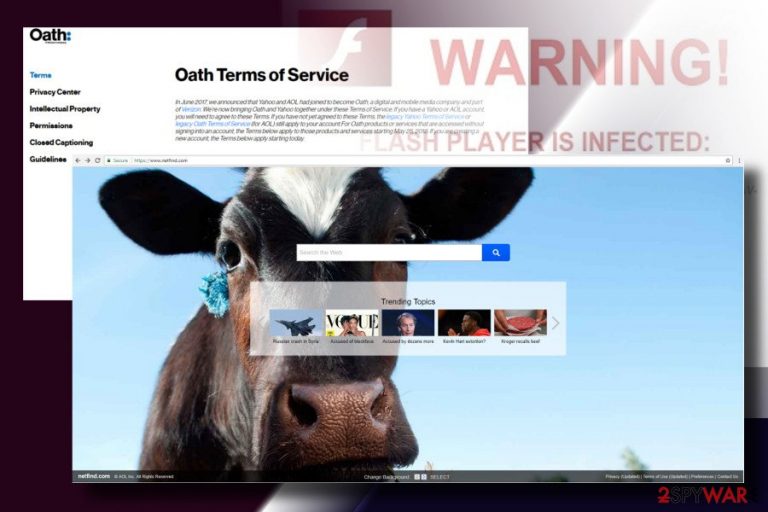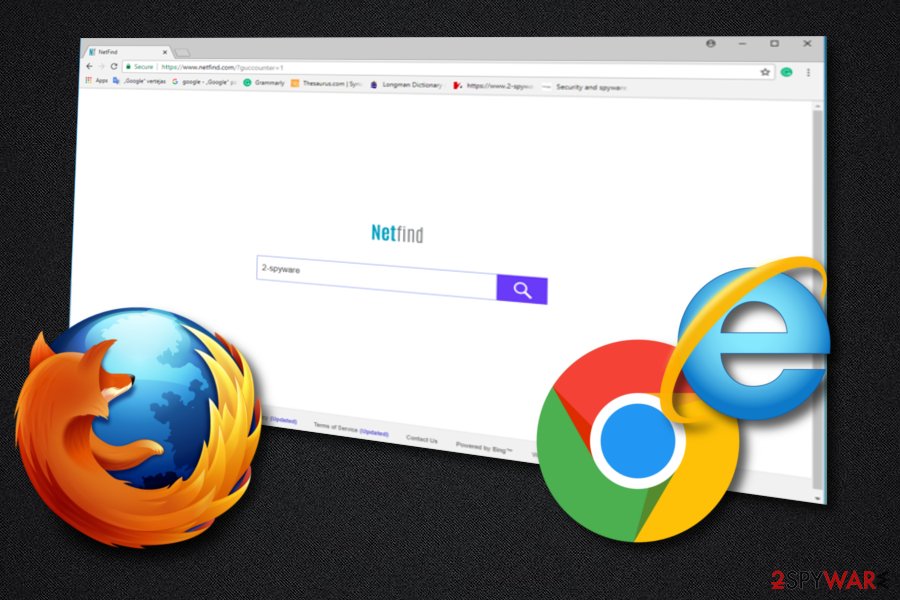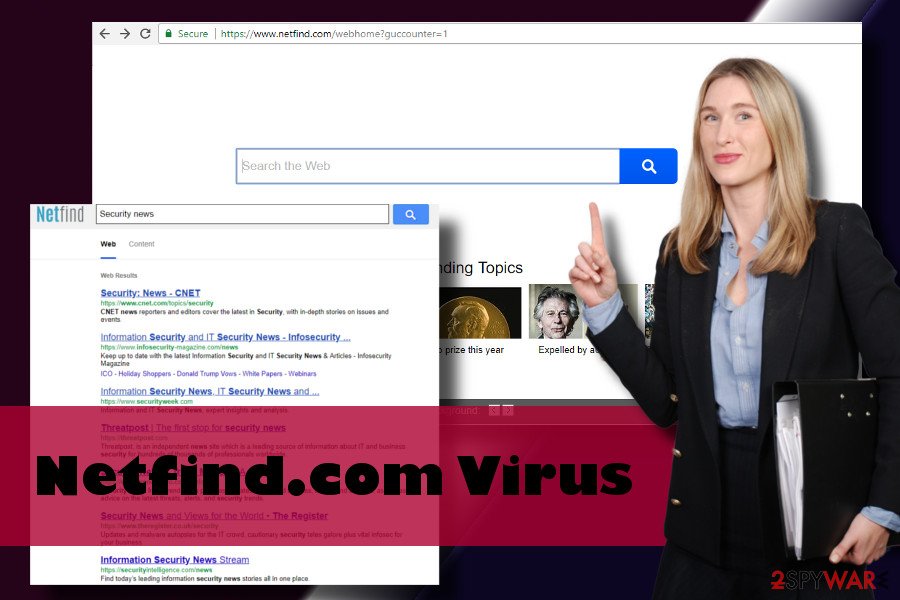Netfind.com Virus (Removal Guide) - updated May 2018
Netfind.com virus Removal Guide
What is Netfind.com Virus?
Netfind – a browser-hijacking app capable of compromising systems without authorization

Netfind is a browser hijacker that was developed and maintained by AOL Inc.[1] From the initial inspection, it looks like a legitimate search site named Netfind.com with a search bar and some customization settings included on the startup page. However, reputable security vendors recognize it as a browser hijacker and potentially unwanted program (PUP). It is capable of installing on target PCs via freeware stacks and substituting the default startup page and search engine with Netfind.com URL. Remember, the fake search engine does not bring any true value as it usually provides misleading search results.
| Name | Netfind.com |
|---|---|
| Type of malware | Browser hijacker |
| Main dangers | Can redirect to malicious web domains, track personally non-identifiable data, generate intrusive ads |
| Main symptoms |
Corrupted web browser's settings, an excessive amount of pop-up ads, redirects to irrelevant websites |
| Danger level | Low |
| Browsers affected | Google Chrome, Mozilla Firefox, Internet Explorer, etc. |
| Elimination | Download FortectIntego and run a scan to get rid of PUPs. |
Netfind.com browser hijacker has been included in PUP database[2] since 2017 soon after cybersecurity experts found it spreading as an attachment of various free programs. Consequently, thousands of people installed it without even being aware of that. Upon installation, the Netfind virus seeks to take control over Chrome, Firefox, IE, Edge, Firefox or another web browser present on the system. Thus, it does the following changes:
- Disables confronting extensions;
- Replaces startup page and search provider;
- Changes a default URL address;
- Drops tracking cookies and monitors user's web browsing activities;
- Installs BHO (Browser Helper Objects) to evade Netfind.com removal;
- Displays excessive amounts of ads that belong to the affiliate parties;
- Provides altered search results that contain links to sponsored websites.
Although the PUP cannot harm the system on its own, it should not be used as equally as Google or Bing. Its purpose is to drive traffic to the websites of its partners and generate advertising revenue. You need to remove Netfind virus from your computer system before it causes any other unwanted consequences. For this case, download and install an anti-malware program such as FortectIntego. Feel free to use any other trusted tool if wanted.
The problem is that no one ensures the security of the partner's content. By using the provided fake search engine, you risk clicking on a link that is connected to a malicious or potentially malicious web domain that contains infected ads, fake updates, survey scams, and similar content. To avoid such possibilities, perform the Netfind removal as soon as you spot the browser modifications.

According to NoVirus.uk[3] analysis, this kind of potentially unwanted programs can also use cookies[4] and other tracking software without authorization. Netfind.com has an ability to collect data that is related to the user's browsing experience. Such details involve your IP address, saved bookmarks, pages and sites visited, photos viewed, and other similar components.
By the way, we would also like to mention that the Netfind.com virus is related to the infamous Yahoo search, which was discontinued a couple of years ago due to data leakage and other illicit activities. As pointed out, following Yahoo ban, AOL and Yahoo have been joined and become Oath.
In June 2017, we announced that Yahoo and AOL had joined to become Oath, a digital and mobile media company and part of Verizon. We’re now bringing Oath and Yahoo together under these Terms of Service.

Browser hijackers arrive in freeware bundles
To maximize the number of downloads, PUP developers append their products (add-ons, toolbars, extensions, etc.) to freeware and shareware as “optional components.” The whole freeware stack is installed without unfurling if the PC's user opts for Quick or Recommended installation option. Therefore, if you want to crack the bundle before installing it, you should choose Advanced installation option and check what the installation setup claims. If there's a point stating that clicking the Next button is treated as your consent to install all freeware components, unmark each additional component before hitting the Next.
Moreover, be careful while surfing the Internet as various PUPs and other serious infections might occur anywhere. Stay away from sites that are provided by secondary sources e.g. P2P networks[5]. Always be concentrated while proceeding various actions on the web. Furthermore, install an antivirus program that will detect various threats that your eye did not capture along the way.

Learn how to remove Netfind virus easily
Do not ignore abnormal activity of this browser hijacker. It's not only intrusive but can also expose your PC to various cyber threats and lead to malware infiltration. To restore your web browser's, such as Google Chrome, Mozilla Firefox, Internet Explorer, Safari, settings as they were before the Net Find attack, you'll have to remove Netfind virus first.
Although manual Netfind.com removal possibility exists, we would not recommend doing that. It's not clear how the program responsible for the hijack means, so you may need to initiate research on most of the apps installed on your PC to find out if it's malicious or not. However, you will be able to find manual elimination instructions below the article.
Instead of that, get rid of Netfind hijack with the help of a reputable anti-virus tool. Run a full system scan, and it will eliminate all PUPs in no time. Browsers such as Chrome, Firefox, Explorer, and others, will be able to function properly again as there will be no more active components that might have got thru the system during the infection.
You may remove virus damage with a help of FortectIntego. SpyHunter 5Combo Cleaner and Malwarebytes are recommended to detect potentially unwanted programs and viruses with all their files and registry entries that are related to them.
Getting rid of Netfind.com virus. Follow these steps
Uninstall from Windows
Delete the browser hijacker from Windows by using these instructions:
Instructions for Windows 10/8 machines:
- Enter Control Panel into Windows search box and hit Enter or click on the search result.
- Under Programs, select Uninstall a program.

- From the list, find the entry of the suspicious program.
- Right-click on the application and select Uninstall.
- If User Account Control shows up, click Yes.
- Wait till uninstallation process is complete and click OK.

If you are Windows 7/XP user, proceed with the following instructions:
- Click on Windows Start > Control Panel located on the right pane (if you are Windows XP user, click on Add/Remove Programs).
- In Control Panel, select Programs > Uninstall a program.

- Pick the unwanted application by clicking on it once.
- At the top, click Uninstall/Change.
- In the confirmation prompt, pick Yes.
- Click OK once the removal process is finished.
Delete from macOS
Mac users should eliminate the infection by following these steps:
Remove items from Applications folder:
- From the menu bar, select Go > Applications.
- In the Applications folder, look for all related entries.
- Click on the app and drag it to Trash (or right-click and pick Move to Trash)

To fully remove an unwanted app, you need to access Application Support, LaunchAgents, and LaunchDaemons folders and delete relevant files:
- Select Go > Go to Folder.
- Enter /Library/Application Support and click Go or press Enter.
- In the Application Support folder, look for any dubious entries and then delete them.
- Now enter /Library/LaunchAgents and /Library/LaunchDaemons folders the same way and terminate all the related .plist files.

Remove from Microsoft Edge
As soon as all PUPs are gone, you can restore the settings of your web browser that were set before the attack. For that, you should:
Delete unwanted extensions from MS Edge:
- Select Menu (three horizontal dots at the top-right of the browser window) and pick Extensions.
- From the list, pick the extension and click on the Gear icon.
- Click on Uninstall at the bottom.

Clear cookies and other browser data:
- Click on the Menu (three horizontal dots at the top-right of the browser window) and select Privacy & security.
- Under Clear browsing data, pick Choose what to clear.
- Select everything (apart from passwords, although you might want to include Media licenses as well, if applicable) and click on Clear.

Restore new tab and homepage settings:
- Click the menu icon and choose Settings.
- Then find On startup section.
- Click Disable if you found any suspicious domain.
Reset MS Edge if the above steps did not work:
- Press on Ctrl + Shift + Esc to open Task Manager.
- Click on More details arrow at the bottom of the window.
- Select Details tab.
- Now scroll down and locate every entry with Microsoft Edge name in it. Right-click on each of them and select End Task to stop MS Edge from running.

If this solution failed to help you, you need to use an advanced Edge reset method. Note that you need to backup your data before proceeding.
- Find the following folder on your computer: C:\\Users\\%username%\\AppData\\Local\\Packages\\Microsoft.MicrosoftEdge_8wekyb3d8bbwe.
- Press Ctrl + A on your keyboard to select all folders.
- Right-click on them and pick Delete

- Now right-click on the Start button and pick Windows PowerShell (Admin).
- When the new window opens, copy and paste the following command, and then press Enter:
Get-AppXPackage -AllUsers -Name Microsoft.MicrosoftEdge | Foreach {Add-AppxPackage -DisableDevelopmentMode -Register “$($_.InstallLocation)\\AppXManifest.xml” -Verbose

Instructions for Chromium-based Edge
Delete extensions from MS Edge (Chromium):
- Open Edge and click select Settings > Extensions.
- Delete unwanted extensions by clicking Remove.

Clear cache and site data:
- Click on Menu and go to Settings.
- Select Privacy, search and services.
- Under Clear browsing data, pick Choose what to clear.
- Under Time range, pick All time.
- Select Clear now.

Reset Chromium-based MS Edge:
- Click on Menu and select Settings.
- On the left side, pick Reset settings.
- Select Restore settings to their default values.
- Confirm with Reset.

Remove from Mozilla Firefox (FF)
Remove dangerous extensions:
- Open Mozilla Firefox browser and click on the Menu (three horizontal lines at the top-right of the window).
- Select Add-ons.
- In here, select unwanted plugin and click Remove.

Reset the homepage:
- Click three horizontal lines at the top right corner to open the menu.
- Choose Options.
- Under Home options, enter your preferred site that will open every time you newly open the Mozilla Firefox.
Clear cookies and site data:
- Click Menu and pick Settings.
- Go to Privacy & Security section.
- Scroll down to locate Cookies and Site Data.
- Click on Clear Data…
- Select Cookies and Site Data, as well as Cached Web Content and press Clear.

Reset Mozilla Firefox
If clearing the browser as explained above did not help, reset Mozilla Firefox:
- Open Mozilla Firefox browser and click the Menu.
- Go to Help and then choose Troubleshooting Information.

- Under Give Firefox a tune up section, click on Refresh Firefox…
- Once the pop-up shows up, confirm the action by pressing on Refresh Firefox.

Remove from Google Chrome
People whose Chrome has been hijacked by Netfind.com virus should follow this below-given tutorial to fix the current situation:
Delete malicious extensions from Google Chrome:
- Open Google Chrome, click on the Menu (three vertical dots at the top-right corner) and select More tools > Extensions.
- In the newly opened window, you will see all the installed extensions. Uninstall all the suspicious plugins that might be related to the unwanted program by clicking Remove.

Clear cache and web data from Chrome:
- Click on Menu and pick Settings.
- Under Privacy and security, select Clear browsing data.
- Select Browsing history, Cookies and other site data, as well as Cached images and files.
- Click Clear data.

Change your homepage:
- Click menu and choose Settings.
- Look for a suspicious site in the On startup section.
- Click on Open a specific or set of pages and click on three dots to find the Remove option.
Reset Google Chrome:
If the previous methods did not help you, reset Google Chrome to eliminate all the unwanted components:
- Click on Menu and select Settings.
- In the Settings, scroll down and click Advanced.
- Scroll down and locate Reset and clean up section.
- Now click Restore settings to their original defaults.
- Confirm with Reset settings.

Delete from Safari
Remove unwanted extensions from Safari:
- Click Safari > Preferences…
- In the new window, pick Extensions.
- Select the unwanted extension and select Uninstall.

Clear cookies and other website data from Safari:
- Click Safari > Clear History…
- From the drop-down menu under Clear, pick all history.
- Confirm with Clear History.

Reset Safari if the above-mentioned steps did not help you:
- Click Safari > Preferences…
- Go to Advanced tab.
- Tick the Show Develop menu in menu bar.
- From the menu bar, click Develop, and then select Empty Caches.

After uninstalling this potentially unwanted program (PUP) and fixing each of your web browsers, we recommend you to scan your PC system with a reputable anti-spyware. This will help you to get rid of Netfind.com registry traces and will also identify related parasites or possible malware infections on your computer. For that you can use our top-rated malware remover: FortectIntego, SpyHunter 5Combo Cleaner or Malwarebytes.
How to prevent from getting stealing programs
Stream videos without limitations, no matter where you are
There are multiple parties that could find out almost anything about you by checking your online activity. While this is highly unlikely, advertisers and tech companies are constantly tracking you online. The first step to privacy should be a secure browser that focuses on tracker reduction to a minimum.
Even if you employ a secure browser, you will not be able to access websites that are restricted due to local government laws or other reasons. In other words, you may not be able to stream Disney+ or US-based Netflix in some countries. To bypass these restrictions, you can employ a powerful Private Internet Access VPN, which provides dedicated servers for torrenting and streaming, not slowing you down in the process.
Data backups are important – recover your lost files
Ransomware is one of the biggest threats to personal data. Once it is executed on a machine, it launches a sophisticated encryption algorithm that locks all your files, although it does not destroy them. The most common misconception is that anti-malware software can return files to their previous states. This is not true, however, and data remains locked after the malicious payload is deleted.
While regular data backups are the only secure method to recover your files after a ransomware attack, tools such as Data Recovery Pro can also be effective and restore at least some of your lost data.
- ^ Oath Terms of Service. Path. A Verizon company.
- ^ Larry Loeb. Malwarebytes Thinks Potentially Unwanted Programs Are Malware. SecurityIntelligence. Information about security industry.
- ^ Novirus. Novirus. Virus and Spyware news.
- ^ What is an Internet cookie?. How Stuff Works.
- ^ Peer-to-peer. Wikipedia. The free encyclopedia.
